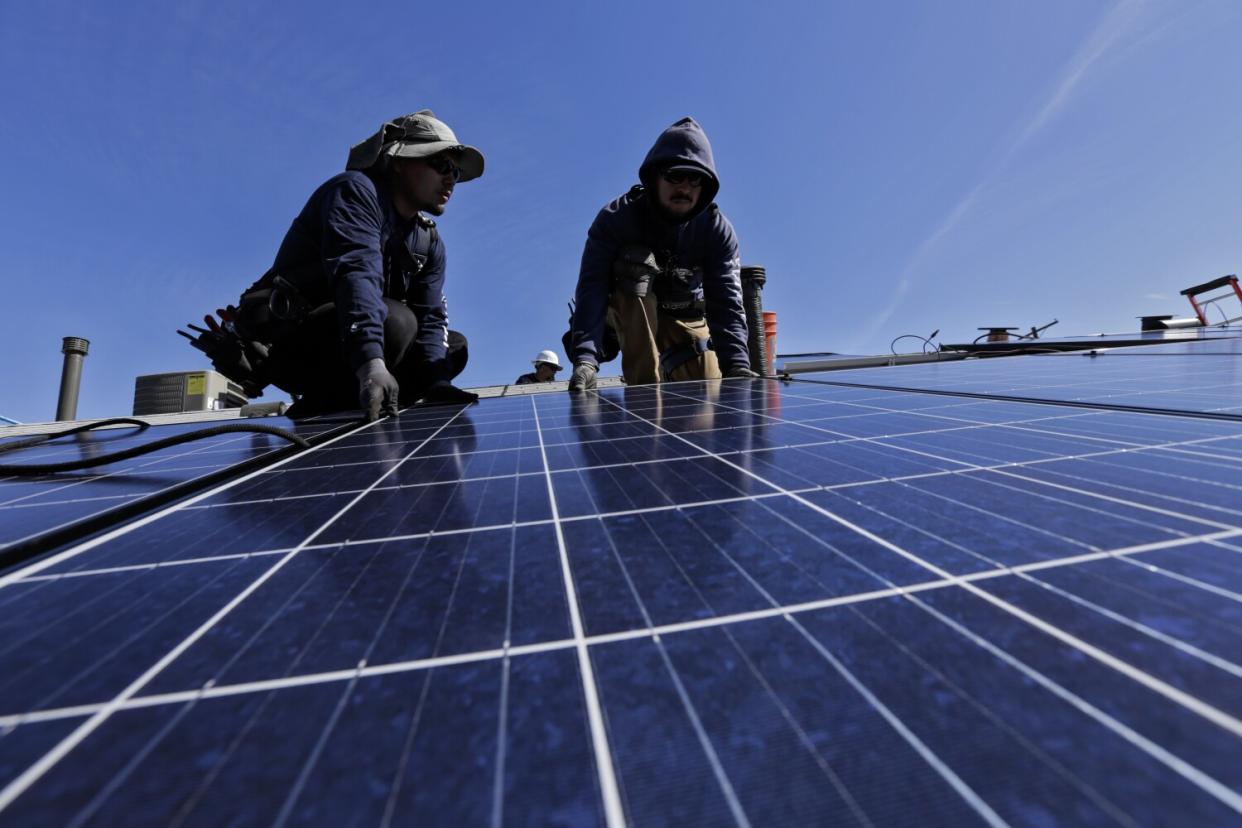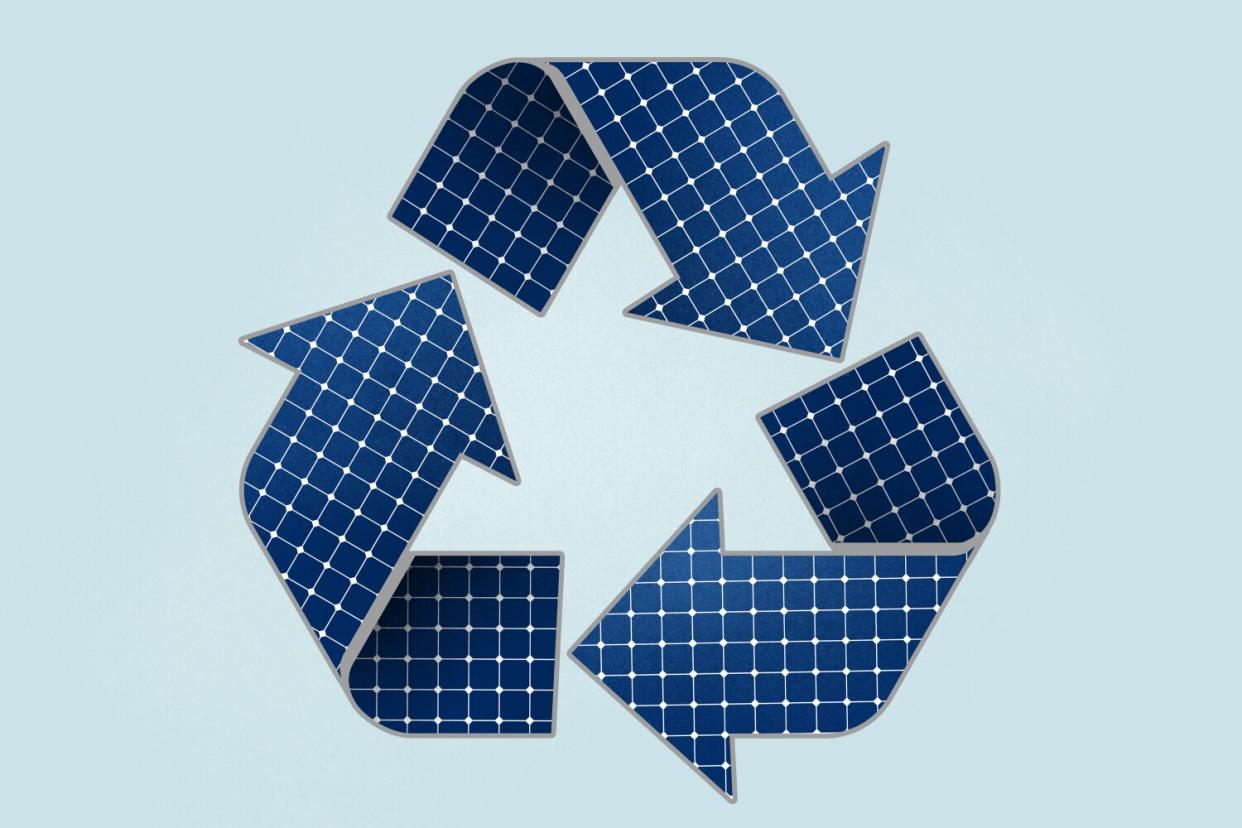California went big on rooftop solar. It created an environmental danger in the process

California has been a pioneer in pushing for rooftop solar power, building up the largest solar market in the U.S. More than 20 years and 1.3 million rooftops later, the bill is coming due.
Beginning in 2006, the state, focused on how to incentivize people to take up solar power, showered subsidies on homeowners who installed photovoltaic panels but had no comprehensive plan to dispose of them. Now, panels purchased under those programs are nearing the end of their 25-year lifecycle.
Many are already winding up in landfills, where components that contain toxic heavy metals such as selenium and cadmium can contaminate groundwater.
“People just don't realize that there are toxic materials in those electronics, that it's fine if it's just sitting in a box in your house,” said Natalie Click, a doctoral candidate in materials science at the University of Arizona who studies the issue. “But once it gets crushed and put into the landfill, a lot of those toxic chemicals and materials are going to leak into your groundwater.”
Sam Vanderhoof, a solar industry expert, says that only 1 in 10 panels are actually recycled, according to estimates drawn from International Renewable Energy Agency data on decommissioned panels and from industry leaders.
The looming challenge over how to handle truckloads of contaminated waste illustrates how cutting-edge environmental policy can create unforeseen hazards down the road.
“The industry is supposed to be green,” Vanderhoof said. “But in reality, it’s all about the money.”
California came early to solar power. Small governmental rebates did little to bring down the price of solar panels or to encourage their adoption until 2006, when the California Public Utilities Commission formed the California Solar Initiative. That granted $3.3 billion in subsidies for installing solar panels on rooftops.
The measure exceeded its goals, bringing down the price of solar panels and boosting the share of the state’s electricity produced by the sun. Because of that and other measures, such as requirements that utilities buy a portion of their electricity from renewable sources, solar power now accounts for 15% of the state’s power.
But as California barreled ahead on its renewable-energy program, focusing on rebates and — more recently — a proposed solar tax, questions about how to handle the toxic waste that would accrue years later were never fully addressed. Now, both regulators and panel manufacturers are realizing that they don’t have the capacity to handle what comes next.
“This trash is probably going to arrive sooner than we expected and it is going to be a huge amount of waste,” said Serasu Duran, an assistant professor at the University of Calgary's Haskayne School of Business in Canada. “But while all the focus has been on building this renewable capacity, not much consideration has been put on the end of life of these technologies.”
Duran co-wrote a recent article in the Harvard Business Review that noted the industry’s “capacity is woefully unprepared for the deluge of waste that is likely to come.”
It’s not just a problem in California but also nationwide. About 140,000 panels are installed every day in the United States, and the solar industry is expected to quadruple in size between 2020 and 2030.
Although 80% of a typical photovoltaic panel is made of recyclable materials, disassembling them and recovering the glass, silver and silicon is extremely difficult.
“There's no doubt that there will be an increase in the solar panels entering the waste stream in the next decade or so,” said AJ Orben, vice president of We Recycle Solar, a Phoenix-based company that breaks down panels and extracts the valuable metals while disposing of toxic elements. “That's never been a question.”
The vast majority of We Recycle Solar’s business comes from California, but the company has no facilities in the state. Instead, the panels are trucked to a site in Yuma, Ariz. That’s because California’s rigorous permitting system for toxic materials makes it exceedingly difficult to set up shop, Orben said.
Recycling solar panels isn’t a simple process. Highly specialized equipment and workers are needed to separate the aluminum frame and junction box from the panel without shattering it into glass shards. Specialized furnaces are used to heat panels to recover silicon. In most states, panels are classified as hazardous materials, which require expensive restrictions on packaging, transport and storage.
Orben said the economics of the process don’t make a compelling case for recycling.
Only about $2 to $4 worth of materials are recovered from each panel. The majority of processing costs are tied to labor, and Orben said even recycling panels at scale would not be more economical.
Most research on photovoltaic panels is focused on recovering solar-grade silicon to make recycling economically viable.
That skews the economic incentives against recycling. The National Renewable Energy Laboratory estimated that it costs roughly $20 to $30 to recycle a panel versus $1 to $2 to send it to a landfill.
Most experts assume that is where the majority of panels are ending up right now. But it’s anyone’s guess. Click said there is no uniform system “for tracking where all of these decommissioned panels are going.”
The California Department of Toxic Substances collected its first data on panels recycled by universal waste handlers in 2021. For handlers that accepted more than 200 pounds or generated more than 10,000 pounds of panels, the DTSC counted 335 panels accepted for recycling, said Sanford Nax, a spokesman for the agency.
The department expects the number of installed solar panels in the next decade to exceed hundreds of millions in California alone, and that recycling will become even more crucial as cheaper panels with shorter lifespans become more popular.
A lack of consumer awareness about the toxicity of materials in the panels and how to dispose of them is part of the problem, experts said.
“There's an informational gap, there's a technological gap, and there's a financial gap that we're working on,” said Amanda Bybee, co-founder of SolarRecycle.org, a website aimed at helping people understand how to recycle solar panels and how the process works.
The website lists two locations in California that recycle panels, but Bybee notes that the website is based on user-submitted information and isn’t comprehensive. At least one of the California locations listed, Fabtech Enterprises, ships panels to confidential off-site recycling partners.
Last year, new DTSC regulation came into effect that reclassified the panels, changing the way they can be collected and transported. Previously, all panels were required to be treated as hazardous waste upon removal, which restricted transportation and storage.
Both business and residential consumers, or generators as they are called in the recycling industry, were supposed to transport the cells themselves to certified recycling or hazardous waste disposal facilities. With little tracking, it’s unclear how frequently that occurred.

Now, panels are classified as universal waste and can be collected at more than 400 universal waste handlers in California, where they are then assessed and transported to disposal, reuse or recycle facilities. The new regulations were intended to make it easier for people to turn in their panels, but it does not directly address the next step — recycling.
“What that [rule] does is really just changes how that material is handled, managed, stored, and transported,” said Orben of We Recycle Solar. “It doesn't change how that material is actually processed.”
In 2016, the Solar Energy Industry Assn., a nonprofit trade association for the U.S. solar industry, started a recycling program for panels. Robert Nicholson, the manager of PV Recycling at the association, said it aims to help the industry group's recycling partners — five so far — “develop compliant, cost-effective recycling services for end-of-life modules.”
“The majority of recyclers are already existing recyclers; they're primarily doing e-waste or they're doing glass,” said Jen Bristol, the Solar Energy Industry Assn.'s senior director of communications. “So we have had to work with them to kind of take that leap, to say: ‘We believe that the processes you're using can accommodate the technology.’” The association also works with regulators to draft legislation that decreases the number of panels heading to landfills.
Government subsidies are one way to make solar panel recycling economically viable for the waste generators, who now bear much of the cost of recycling.
In Europe, a recently enacted regulation called the European Union Waste of Electrical and Electronic Equipment Directive places responsibility on producers for supporting their products through responsible end-of-life disposal. It requires all producers that manufacture panels for countries in the EU to finance end-of-life collection and recycling.
Similar legislation has been attempted in several U.S. states, including Washington, where the Photovoltaic Module Stewardship and Takeback Program will require solar panel manufacturers to finance end-of-life recycling. The initiative was passed in 2017 and will begin implementation in 2025. It’s the only producer-responsibility law in the United States.
It’s part of a larger strategy in the recycling industry called extended producer responsibility, in which the cost of recycling is built into the cost of a product at its initial purchase. Business entities in the product chain — rather than the general public — become responsible for end-of-life costs, including recycling costs.
Jigar Shah, co-founder of Generate Capital, a fund that invests in sustainable infrastructure, said the problem can be addressed at the very start of the product chain — by manufacturers. He said that policymakers need to require manufacturers to come up with a standard design that makes panels easier and cheaper to recycle.
“It’s far more cost-effective for manufacturers to be forced to work together … where they try to greatly reduce the cost of all that collectively. That happens through policy,” he said. “It doesn’t happen through people opting in.”

In April 2022, Santa Monica concluded a solar panel recycling pilot program in partnership with the California Product Stewardship Council, a public-private partnership. The stewardship council surveyed local residential solar owners and found that many, at a loss for what to do with end-of-life panels, called up installers for help.
“We did find that the solar installers were the best contact for us to learn about how many decommissioned panels were in our region,” said Drew Johnstone, a sustainability analyst for Santa Monica. “Some contractors did end up just having to pile them in their warehouses, because there's no good solution for where to bring them.”
Johnstone says the universal waste reclassification has made a big difference, cutting down on cost and paperwork needed for handling modules, and more handlers can accept the panels from generators.
“It's going to be a really large issue in a number of years,” Johnstone said. “So it would behoove local governments, county, state, and it can go federal too, to have a plan in place for all these panels that will reach their end of life in 10 to 15 years.”
Kisela is a special correspondent.
This story originally appeared in Los Angeles Times.
